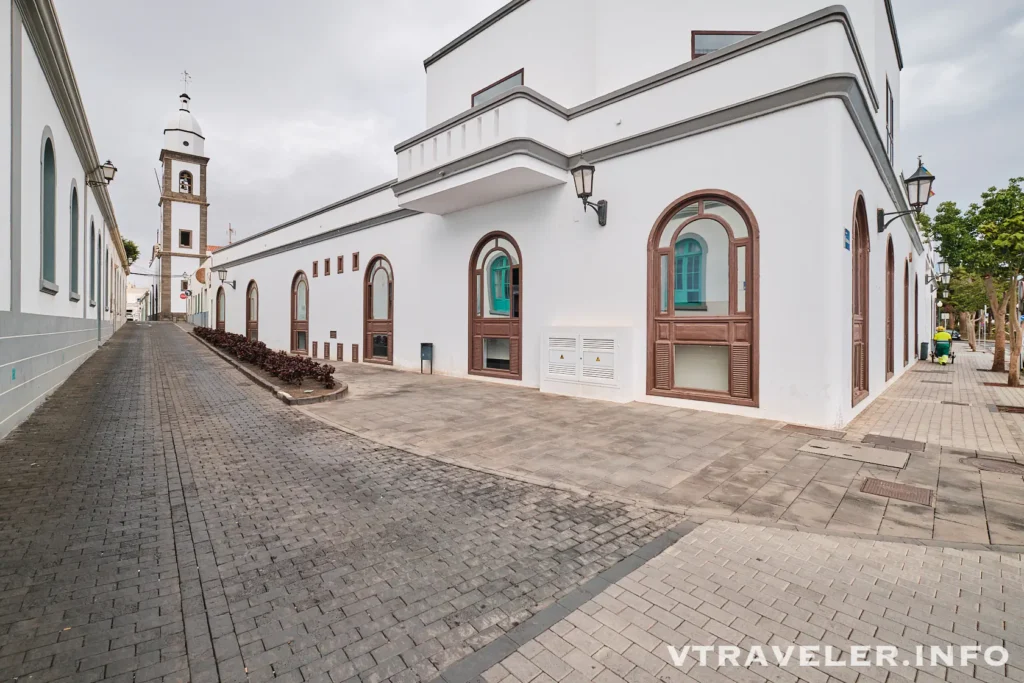Arrecife, the capital of Lanzarote, offers a fascinating blend of cultural, historical, and natural attractions. In just one day, you can explore its main tourist landmarks, which showcase the city’s unique character and history.
Description
Arrecife is a small but picturesque city located on the eastern coast of Lanzarote, part of the Canary Islands. Its name, meaning “reef,” derives from the numerous reefs surrounding its shores. The city offers visitors charming beaches, historical buildings, and remarkable monuments that reflect the island’s rich heritage.
History
Key Moments in the Development of Lanzarote’s Capital
Arrecife boasts a long and storied history, situated on the eastern coast of Lanzarote, one of the Canary Islands. In this section, we will explore the major milestones in Arrecife’s development, from its origins as a small fishing village to becoming the capital of Lanzarote.
Early Settlements
The history of Arrecife begins with the first settlements of the indigenous Guanches, who inhabited Lanzarote long before Spanish colonization. The site, which later became known as Arrecife, was a small coastal village, protected by natural reefs that acted as barriers against ocean waves and potential threats.
The Guanches utilized Lanzarote’s natural resources for fishing and farming. However, due to limited written records from this period, most knowledge of the early inhabitants of Arrecife comes from archaeological findings.
Colonization and Early Pirate Attacks
Spanish colonization of the Canary Islands began in the early 15th century, and Lanzarote was the first island to be conquered by Europeans. In 1402, French explorer Jean de Béthencourt, under the Spanish flag, claimed Lanzarote, initiating Spanish rule over the archipelago.
By the 16th century, Arrecife began to gain attention due to its convenient port, used for fishing and trade. However, the island’s location in the Atlantic made it vulnerable to pirate raids. During this period, Lanzarote, including Arrecife, was frequently attacked by pirates and Berber raiders.
One of the most notable events was the attack in 1571, when Turkish pirate Murad Reis raided Lanzarote and captured many locals into slavery. These raids significantly hindered the development of settlements on the island and spurred defensive fortifications.
Construction of Fortresses
To protect against pirates, fortifications were built in Arrecife during the 16th and 17th centuries. One of the first such structures was Castillo de San Gabriel, built in 1573 on a small island near the shore. The fortress served as a key defense point against pirate attacks. After being destroyed in 1596, the fortress was soon rebuilt, and the Puente de las Bolas (Bridge of the Balls) was constructed to connect the island with the mainland of Arrecife.
Rise of Arrecife and Economic Growth
In the 18th century, Arrecife gradually became the primary trading and fishing center of Lanzarote. Despite ongoing pirate threats, economic activity grew thanks to the convenient location of the port. Arrecife became a key export hub for agricultural products, including grapes and the famous Lanzarote wine, which was shipped to Spain and other European countries.
Although Villa de Teguise remained the administrative center of the island during this time, Arrecife began to gain more economic importance, leading to eventual administrative changes.
Capital Status and 19th Century Growth
In 1852, Arrecife was officially named the capital of Lanzarote, replacing Villa de Teguise, which had long been the political center of the island. This status contributed to the further development of the city. Arrecife expanded rapidly, with its port continuing to be the main source of economic activity on the island.
In the 19th century, infrastructure and maritime routes with mainland Spain and other Canary Islands improved, leading to population growth and increased trade.
20th Century: Modernization and Tourism
The 20th century brought new challenges and opportunities to Arrecife. In the early part of the century, the city’s economy was still based on fishing and agriculture. However, over time, tourism became the main economic driver for the entire island of Lanzarote.
After World War II, the city began developing tourist infrastructure, and the number of visitors increased steadily. Lanzarote, thanks to its unique landscapes and favorable climate, became a popular tourist destination. As the capital and main port, Arrecife reaped the benefits of this growth.
Modern Arrecife
Today, Arrecife retains its rich historical heritage, combining old fortifications and traditional houses with modern urban facilities. Castillo de San Gabriel, which once defended the city from pirates, is now a museum and one of the main attractions of Arrecife. The city also serves as the administrative center of Lanzarote and an important cultural hub.
The history of Arrecife is one of overcoming challenges related to geographic isolation and external threats, but thanks to its strategic location and the determination of its people, the city has become a dynamic center of the island.
Attractions
Arrecife, the capital of Lanzarote, is full of interesting and diverse attractions. If you’re wondering what to see in a day, here is a list of must-visit landmarks. Whether you’re exploring historical fortresses, modern sculptures, or scenic promenades, Arrecife offers a wide variety of experiences for tourists.
Charco de San Ginés

A natural lagoon surrounded by picturesque white houses, perfect for a relaxing walk along the waterfront. It’s a great place to enjoy the natural beauty of the area.
Esqueleto de Ballena
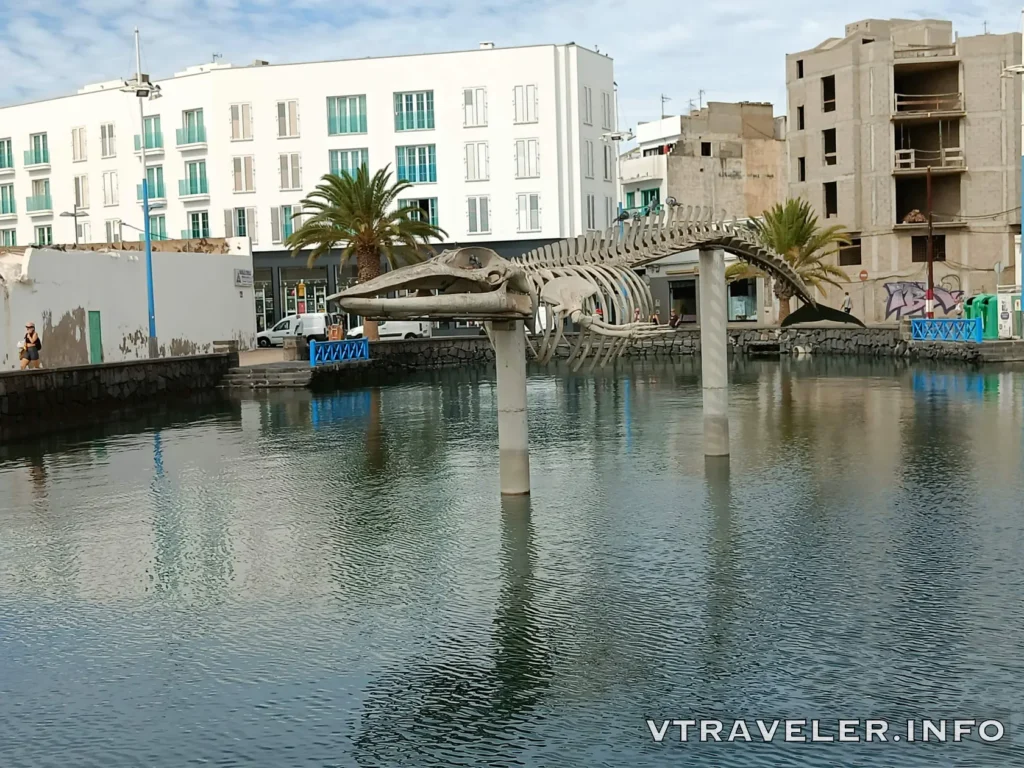
This massive sculpture of a whale skeleton draws attention with its impressive scale. It symbolizes the importance of environmental conservation and marine ecosystems.
Escultura Buches (Evelina Martín)
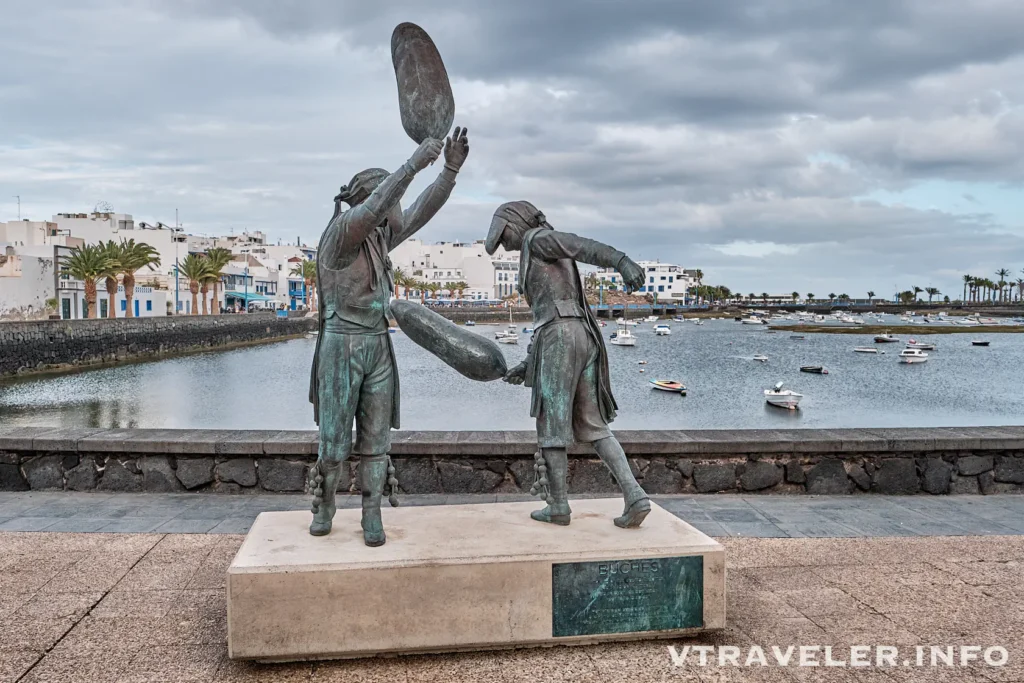
Created by local artist Evelina Martín, this sculpture is dedicated to Arrecife’s traditional carnival and its cultural significance. A vivid example of modern art in the city.
Calle León y Castillo

The main street in Arrecife, where visitors can find many shops, cafes, and restaurants. It’s a great spot to take in the local atmosphere.
La Casa Amarilla

Once serving as an administrative building, La Casa Amarilla is now a cultural center and museum. It hosts temporary exhibitions about the culture and history of Lanzarote.
Statue of Heraclio Niz Mesa

This monument is dedicated to Heraclio Niz Mesa, a famous local athlete who made significant contributions to sports on the island.
Puente de las Bolas

The stone bridge from the 16th century that leads to Castillo de San Gabriel. It is one of Arrecife’s landmarks and an architectural masterpiece of its time.
Castillo de San Gabriel

A fortress on a small islet near Arrecife, built to defend the city from pirates. Today, it houses a museum where visitors can learn more about the city’s maritime history.
Playa del Castillo
A small but cozy beach located near Castillo de San Gabriel, ideal for relaxing and swimming.
Museo Internacional de Arte Contemporáneo Castillo de San José

This contemporary art museum is housed in the old fortress of Castillo de San José. It offers a unique collection of artworks, as well as stunning views of the ocean.
Parroquia de San Ginés

The Church of San Ginés is one of Arrecife’s main historical landmarks. Built in the 17th century, it is dedicated to the city’s patron saint.
Parque José Ramírez Cerdá
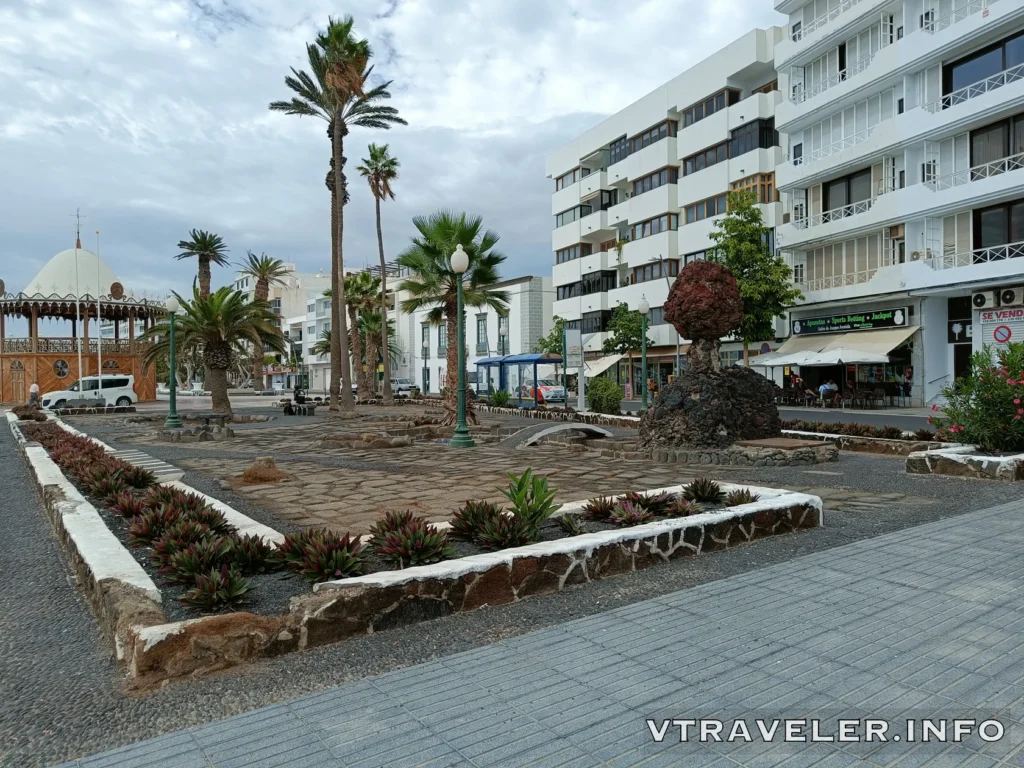
Located in the city center, Parque José Ramírez Cerdá is a great place to relax and take a stroll. The park offers shade and a peaceful atmosphere.
Paseo marítimo de Arrecife

The beautiful seafront promenade is perfect for walking along the coast. It offers breathtaking views of the Atlantic Ocean and fresh sea air.
Estatua de Blas Cabrera Felipe

This monument is dedicated to Blas Cabrera Felipe, a renowned Spanish physicist born on Lanzarote. The statue is located in one of the city’s parks and is a significant cultural landmark.
Islote de Fermina

A small islet connected to the city by a bridge, Islote de Fermina features modern sports and cultural facilities where visitors can relax and engage in various activities.
Playa del Reducto
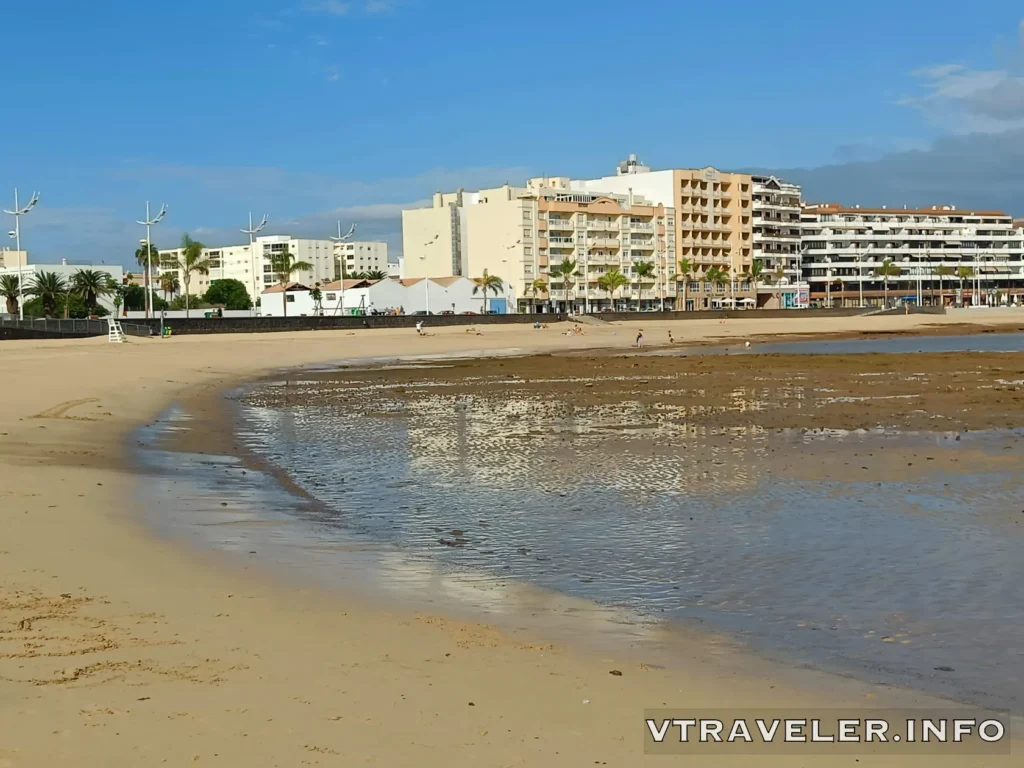
Arrecife’s main beach, Playa del Reducto, offers golden sands and calm waters. It’s a popular spot for family outings and swimming.
How to Get to Arrecife
Getting to Arrecife, the capital of Lanzarote, is easy and convenient. The main transport hub is César Manrique-Lanzarote Airport, located just 5 kilometers from the city. This international airport welcomes regular flights from major cities across Europe.
Once you arrive at the airport, there are several ways to reach Arrecife. The fastest and most convenient option is by taxi, which takes about 10–15 minutes to get to the city center, with fares varying depending on time of day and luggage.
Alternatively, public transport is available. Buses (routes 22 and 23) run regularly from the airport, offering an affordable option with fares around €2 per trip.
For those who prefer more flexibility, car rentals are available at the airport. Lanzarote is a relatively small island with good roads, and the main highway LZ-2 connects the airport to Arrecife, making it easy to drive to the city.
Video
Conclusion
Arrecife is a city that offers a wide range of unique attractions, combining history, art, and natural beauty. In just
one day, tourists can immerse themselves in the rich atmosphere of this fascinating city, enjoying its culture and scenic landscapes.

